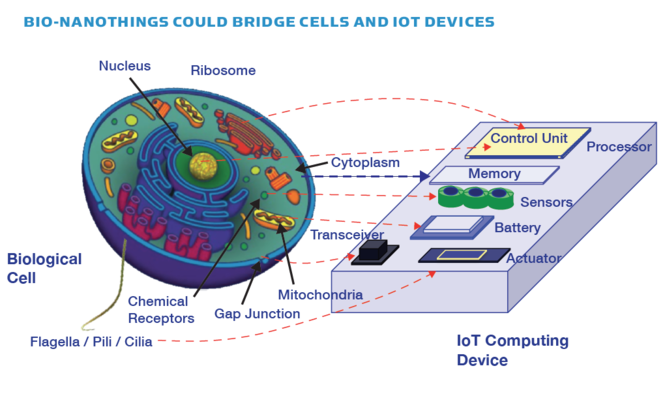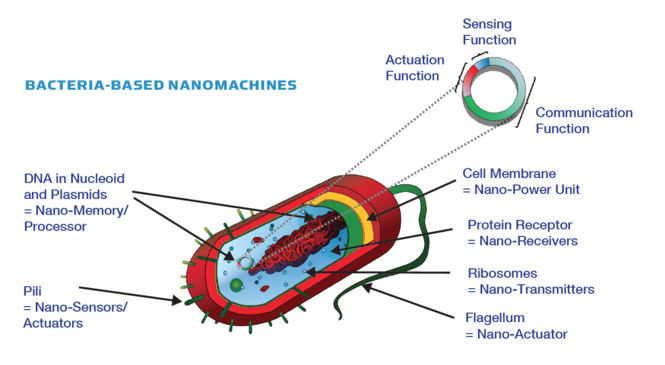Future Now
The IFTF Blog
Evolving Nanoscale Communication
Biology, Engineering, and Robotics Converge
with Dr. Ian Akyildiz
Today, networks of smart devices have already transformed our world, and we’re just starting to connect our bodies to them in meaningful ways. We see signs that we might be able to create new bio-based networks inside our own bodies and manipulate the ones already there. As molecular biology, nanoscale engineering, and robotics converge, we may be able to use microscopic robots to target specific interactions among many natural nanoscale processes within our bodies’ cells. In the next few decades, communications technology could take on a whole new meaning, as we gain the ability to coordinate interactions among these tiny bio-nanobots and natural human bioelectrical functions.
 IFTF researcher Michael Liebhold spoke with Dr. Ian Akyildiz, a preeminent researcher in nanoscale networks. A professor at Georgia Institute of Technology and founder of the Nano Communications Center, Dr. Akyildiz has established several highly regarded research centers.
IFTF researcher Michael Liebhold spoke with Dr. Ian Akyildiz, a preeminent researcher in nanoscale networks. A professor at Georgia Institute of Technology and founder of the Nano Communications Center, Dr. Akyildiz has established several highly regarded research centers.
What is the current status of nanoscale communications in the body?
Nanoscale communications will be a reality in the near term. We’re already working on bacteria communication, investigating how to engineer synthetic programmable bacteria so they can communicate and help the body attack natural bacteria. The significance of this is that genetically engineered bacteria will be able to fight any bacteria-based illness in the human body. We’re investigating cell-to-cell communication among bacteria because as they create and work as colonies—called quorum sensing—billions of bacteria colonies work together.

Can you describe networking and signaling in these environments?
Bacteria communication is based on molecular communication. Bacteria release and diffuse molecules or particles, communicating among bacteria. If you think of bacteria as nanoscale machines, the molecules they release are like messages or packages they use to communicate with other bacteria. Cells use signaling molecules such as calcium ions to control processes. Our investigation involves collaboration among communications, biology, and mechanical engineering teams.

What are some potential uses of nanoscale communications?
We’re looking at how specific components in the body such as calcium, iron, potassium, and astrocytes are communicating. The next step would be to apply our findings on communication to particular illnesses, such as Crohn’s disease or Alzheimer’s disease.
How can human networks communicate with these nanoscale networks?
From nanoscale networks within the human body, we’ll need to create a gateway to the outside. We’re thinking about using a type of nanoscale cell phone that will be the gateway to the outside world, like using the Internet for doctor’s examinations.
We call this the “Internet of Bio-Nano Things.” We can create Bio-Nano Things in the body or in body components as the network, and then we’ll have a gateway or multiple gateways outside the body. Eventually we’ll be able to genetically engineer human cells and program them. The world will be totally different, with billions of nanoscaled devices circulating in the human body as additional red blood cells or white blood cells. As soon as they detect any tumors or diseases, they’ll communicate and attack. In the next 10 to 20 years, practical, wide-scale applications will become a reality. It’s a long-term process.
Can you describe a few highlights from projects in your labs?
All my research centers in the world are taking one of two tracks. One is intrabody molecular communications, using the communication aspects and the nature of calcium ions and other molecular markers. The other track is nanoscale machines, using nanomaterials like graphene, considered nanomaterials because they’re so light and so thin they’re almost two-dimensional. Of course, it’s three-dimensional, but graphene is harder than diamonds and much stronger than steel. Using such materials, we can create nanoscale machines, like nanoantennas, nanotransceivers, and nanobatteries.
Then we’ll be able to create integrated, graphene-based nanoscale machines. We also look at how these machines will communicate. We’re already producing integrated devices.
All the components—transceivers, antennas, and batteries—even the processors already exist. We’re in the process of physically showing that they work.
What are the implications for an interface with neurocommunications?
All these different communications going on within the human body— such as molecular motors, calcium ions, bacteria, neurons, and astrocytes—are now all separate aspects of communication. My research agenda is to learn how these separate islands of communication networks all affect each other?
 FUTURE NOW—The Complete New Body Language Research Collection
FUTURE NOW—The Complete New Body Language Research Collection
The New Body Language research is collected in its entirety in our inaugural issue of Future Now, IFTF’s new print magazine.
Most pieces in this issue focus on the human side of Human+Machine Symbiosis—how body area networks will augment the intentions and expressions that play out in our everyday lives. Some pieces illuminate the subtle, even invisible technologies that broker our outrageous level of connection—the machines that feed off our passively generated data and varying motivations. Together, they create a portrait of how and why we’ll express ourselves with this new body language in the next decade.
For More Information
For more information on the Tech Futures Lab and our research, contact:
Sean Ness | sness@iftf.org | 650.233.9517



